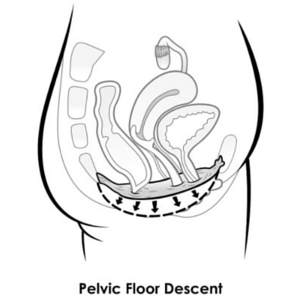
There are common mistakes to avoid for successful pelvic floor exercises.
Unfortunately up to 70% of women perform pelvic floor exercises using the wrong technique if they don’t have individualised instruction.
This Pelvic Floor Physical Therapist information helps you achieve successful pelvic floor exercises for the strength and support you require.
This list is mistakes is not in order or importance. Pelvic floor exercise corrections for common mistakes are listed below to help you get started now.

Pelvic Floor Exercises Workout
AUDIO CD OR DOWNLOAD NOW
Strengthen your pelvic floor with this daily Kegel exercises routine.
This evidence-based pelvic floor exercise workout guides you step by step.
Presented by:
Pelvic Floor Physiotherapist Michelle Kenway
Contents
Track 1 – Introduction to Successful Strengthening
Track 2 – Finding your Pelvic Floor
Track 3 – Feeling your Pelvic Floor Muscles
Track 4 – Using the Correct Pelvic Floor Exercise Technique
Track 5 – Beginners Pelvic Floor Exercises Workout
Track 6 – Intermediate Pelvic Floor Exercises Workout
Track 7 – Progressing and Maintaining your Strength
15 Common Mistakes to Avoid for Successful Pelvic Floor Exercises
1. Bearing Down
Some women mistakenly bear down (push down) on their pelvic floor when doing their pelvic floor exercises. Bearing down through the pelvic floor can stretch and strain the pelvic floor tissues making make pelvic floor problems worse.
 Avoid bearing down exercises causing pelvic floor descent (shown left). It’s imperative to avoid bearing down, especially with pelvic floor exercises after vaginal surgery
Avoid bearing down exercises causing pelvic floor descent (shown left). It’s imperative to avoid bearing down, especially with pelvic floor exercises after vaginal surgery
Correct Exercise Tips
- Lift inwards around all 3 pelvic openings as if stopping or slowing the flow of urine having once started.
- Practice sitting on a chair or exercise ball – try to lift your pelvic openings away from the supporting surface
2. Forgetting to Lift
A common mistake is just squeezing around the pelvic openings with out lifting them inwards.
Correct Exercise Tip
Correct pelvic floor exercise technique involves lifting inwards and squeezing the pelvic floor muscles in and around all 3 pelvic openings at once.
3. Incomplete Muscle Activation
The pelvic floor muscles all 3 pelvic openings; the urethra (urine tube), vagina and anus. Some women focus all their efforts on one opening rather than all 3 openings.
Correct Exercise Tip
Aim for correct pelvic floor exercise technique by squeezing and lifting in and around all three pelvic openings simultaneously when doing your pelvic floor exercises.
4. Insufficient Muscle Relaxation
The pelvic floor muscles need to relax having once contracted. Lack of pelvic floor relaxation with exercises can cause pelvic floor muscle spasm and/or pelvic floor fatigue.
Correct Exercise Tip
Make sure that you lower your pelvic floor muscles back to resting level having once contracted them and rest
5. Over-bracing Abdominal Muscles 
The strong outer abdominal muscles (‘6 pack’ abdominal muscles) shouldn’t contract strongly during pelvic floor exercises.
It’s normal to feel some abdominal wall contraction during pelvic floor exercises however a strong upper abdominal contraction (shown right) should be avoided.
Correct Exercise Tip
Maintain good upright posture and focus on contracting your pelvic floor muscles without drawing your upper abdomen inwards during your pelvic floor exercises.
5. Poor Posture
Slumped forwards posture increase downward pressure on the pelvic floor thereby decreasing the effectiveness of pelvic floor exercises.
Correct Exercise Tip
Maintain correct posture for pelvic floor exercises by lifting the crown of your head towards the ceiling and keep your spine lengthened throughout for most effective pelvic floor exercises.
6. Squeezing your Buttocks
Women sometimes squeeze their buttocks in the mistaken belief that this action constitutes pelvic floor exercises.
Pelvic floor exercises don’t involve buttock muscles squeezing, your buttocks should remain relaxed during your exercises.
Correct Exercise Tips 
- Use a gentle pelvic floor activation technique when starting out – if your buttocks contract stop and start again keeping them relaxed
- Try sitting on an exercise ball or a chair to feel your pelvic floor exercises
- Start by squeezing your buttocks together and feel this action against the surface of the ball
- Next try to activate your pelvic floor muscles without squeezing your buttocks lifting your pelvic openings inwards away from the surface of the ball and notice the different sensation.
7. Squeezing your Thighs
Some ladies squeeze their thighs when attempting to contract their pelvic floor muscles. This is a similar mistake to squeezing the buttocks often used with weak pelvic floor muscles. This gives the mistaken impression that the pelvic floor muscles are working when in fact they may not be.
Correct Exercise Tip
If you find yourself squeezing your thighs try to learn to contract your pelvic floor using a more gentle activation technique. Changing position for your pelvic floor exercises may help you to practice the correct technique.
8. Doing too Many Exercises
When it comes to doing pelvic floor exercises for strengthening, more isn’t necessarily better. In the past women were instructed to perform hundreds of Kegels daily.
Research now tells us that for effective strengthening muscles need a certain dose of exercise and that too much exercise can over fatigue causing muscle weakness.
Correct Exercise Tip
Pelvic floor exercises for strengthening involve up to 8-10 exercises performed in succession (1 set), 2-3 times during the day.
9. Doing too Few Exercises
The pelvic floor muscles need to be exercised to fatigue for most effective strengthening.
When starting out your pelvic floor may become fatigued after a couple of exercises – this is normal. If however you are capable of doing up to 8-10 repetitions in a row, this is the dose your pelvic floor muscles need to strengthen most effectively.
Correct Exercise Tip
As your strength improves gradually increase the number of pelvic floor exercises that you repeat in a row.
10. Lack of Intensity
One reason why some women don’t get the results they’re after with their exercises is due to of a lack of voluntary effort with each exercise.
Successful pelvic floor strengthening requires that every exercise involves a very strong voluntary effort.
Correct Exercise Tips
- When starting out for most women its usually best to use light to moderate effort to ensure that the technique is correct.
- When you’re sure about using the correct technique then start to increase the voluntary effort you use with every exercise.
11. Lack of Recovery Time 
Your pelvic floor muscles need sufficient time to recover between exercises to allow for the next strong effort. Insufficient rest between exercises prevents you from using your maximal effort in the next exercise.
Correct Exercise Tips
- When starting out take the time your pelvic floor muscles need to recover between individual exercises (up to 30-45 seconds if your muscles are weak).
- Gradually decrease the length of rests between individual exercises as your pelvic floor strength and fitness improve.
12. Lack of Attention
Some ladies try to do their pelvic floor exercises while driving the car, doing their makeup or even walking resulting in ineffective pelvic floor strengthening.
Getting the most out of each exercise requires giving it your full attention and maximal voluntary effort.
Correct Exercise Tip
Choose a time to do your exercises when you can give them your undivided attention. It’s more effective to get the most you can out of a few well performed exercises than many poorer attempts.
If you’re busy try to choose a time when you’ve momentarily stopped for example standing in a queue, sitting on the bus
13. Non-Functional Exercise Position
We need our pelvic floor muscles to work effectively in our everyday functional upright positions (i.e. sitting and standing). Some ladies make the mistake of doing all their pelvic floor exercises lying down long-term. Your pelvic floor muscles will strengthen most effectively when trained to work upright against the downward force of gravity
Correct Exercise Tip
- Some women find that they need to commence their pelvic floor exercises lying down and this is quite normal
- Commence your exercises in the position you can best feel your pelvic floor muscles working
- Try to progress your exercises to doing them in upright positions when you’re able to do so. Doing your pelvic floor exercises in sitting or standing will train your pelvic floor muscles to work well when you need them most
14. Lack of Progression
Pelvic floor muscles need to be progressively challenged to work harder during the course of training. Challenging muscles helps you get the most benefit out of strengthening exercises. If you don’t progress your exercises, your muscles wont have the stimulus they need to strengthen further.
Correct Exercise Tips
Progress your pelvic floor exercises by:
- Increasing the strength of your exercises
- Choosing upright training positions
- Reducing rest in between each exercise
- Increasing the number of exercises you do (up to 10-12 in a row)
15. Lack of Training
Sometimes it can be disheartening to see very little improvement and this is understandable. Unfortunately some ladies stop their pelvic floor exercises dismissing them as ineffective when they don’t see immediate results when in fact a little more perseverance may have resulted in a marked improvement in their pelvic floor.
Correct Exercise Tip
Take a long-term approach to your pelvic floor exercises. For some ladies with weak pelvic floor muscles it can take 5-6 months of regular progressive exercises to strengthen their pelvic floor muscles. Commit to regular ongoing pelvic floor exercises to strengthen and then maintain your stronger pelvic floor muscles.
Further Information on Pelvic Floor Exercises
» How Many Pelvic Floor Exercises You Need To Do Today For A Strong Pelvic Floor
» How to do Kegel Exercises Video That Strengthen Your Pelvic Floor
» 12 Practical Kegel Exercises Reminders For Busy Women




 Avoid bearing down exercises causing pelvic floor descent (shown left). It’s imperative to avoid bearing down, especially with
Avoid bearing down exercises causing pelvic floor descent (shown left). It’s imperative to avoid bearing down, especially with 




